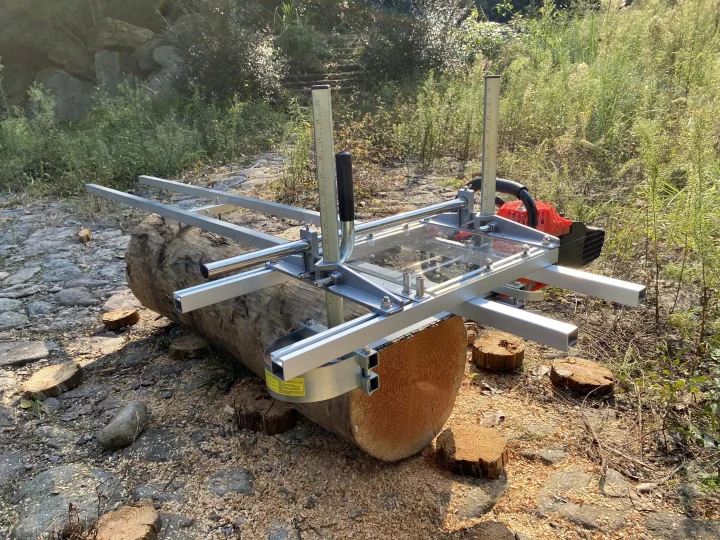If you are a woodworker or a DIY enthusiast, you may have heard of chainsaw mills and bandsaw mills. These two types of mills are commonly used for cutting logs into lumber, but they have some differences that can make them more suitable for specific projects or situations.
In this article, we will explain the pros and cons of a chainsaw mill vs bandsaw mill and help you decide which one is right for you.

Table of Contents
- What Is a Chainsaw Mill?
- What Is a Bandsaw Mill?
- Chainsaw Mill vs Bandsaw Mill: Which One is Right for You?
- Conclusion
- FAQs (Frequently Asked Questions)
What Is a Chainsaw Mill?
A chainsaw mill is a portable tool that attaches to a chainsaw and allows you to cut logs into lumber on-site. The mill consists of a frame that clamps onto the chainsaw bar and a guide rail that guides the chainsaw blade as it cuts through the log. Chainsaw mills are usually smaller and more portable than bandsaw mills, making them ideal for cutting small to medium-sized logs in remote areas.
Pros of Chainsaw Mills
Portability
One of the main advantages of chainsaw mills is their portability. You can easily take the mill and your chainsaw to the location where the logs are and cut them into lumber on-site. This saves you the trouble of transporting the logs to a sawmill, which can be costly and time-consuming.
Related: What is Sawmill
Cost-Effective
Chainsaw mills are generally cheaper than bandsaw mills, making them a great option for DIY enthusiasts who don’t want to invest too much money in a tool they might not use frequently. A good quality chainsaw mill can cost anywhere from $100 to $500, depending on its size and features.
Versatility
Chainsaw mills can be used to cut logs of different sizes and shapes, making them suitable for a variety of woodworking projects. They are also compatible with different types of chainsaws, so you can use the one you already have or buy a new one that suits your needs.
Cons of Chainsaw Mills
Slower Cutting Speed
Chainsaw mills are generally slower than bandsaw mills, especially when it comes to cutting large logs. The chainsaw blade also tends to dull faster, which means you need to sharpen it more often to maintain its cutting performance.
Limited Accuracy
Chainsaw mills are not as accurate as bandsaw mills when it comes to cutting straight lines or producing consistent thicknesses. This can lead to uneven lumber that requires additional processing to make it usable.
Safety Concerns
Using a chainsaw mill requires a certain level of skill and experience, as well as the use of personal protective equipment such as goggles, gloves, and earplugs. Accidents can happen if the chainsaw blade gets stuck or if the log shifts during cutting, so it’s important to follow safety guidelines and use the mill correctly.
What Is a Bandsaw Mill?
A bandsaw mill is a stationary tool that uses a rotating bandsaw blade to cut logs into lumber. The mill consists of a large frame, a motor that powers the blade, and a set of rollers that feed the log through the blade. Bandsaw mills are usually larger and more powerful than chainsaw mills, making them ideal for cutting large logs into lumber in a workshop or a sawmill.
Pros of Bandsaw Mills
Higher Cutting Speed
Bandsaw mills are generally faster than chainsaw mills, especially when it comes to cutting large logs. The blade also stays sharper for longer, which means you can cut more lumber before you need to sharpen or replace it.
Greater Accuracy
Bandsaw mills are capable of producing straighter and more consistent cuts than chainsaw mills, which means you can get lumber with a more uniform thickness and a smoother finish. This can save you time and effort when it comes to processing the lumber.
Safety Features
Bandsaw mills are equipped with safety features such as blade guards, emergency stop buttons, and automatic shut-off switches. This makes them safer to use than chainsaw mills, as there is less risk of accidents occurring.
Cons of Bandsaw Mills
Cost
Bandsaw mills are generally more expensive than chainsaw mills, with prices ranging from $2,000 to $10,000 or more. This makes them less suitable for DIY enthusiasts or small-scale operations that don’t have the budget for a large investment.
Limited Portability
Bandsaw mills are typically large and heavy, which means they are not easy to move around. They are also stationary tools that require a dedicated space to set up and operate, which can be a limitation for those who want to cut logs on-site.
Maintenance
Bandsaw mills require regular maintenance and upkeep, such as blade sharpening, lubrication, and cleaning. This can be time-consuming and expensive, especially if you don’t have the necessary tools or skills to do it yourself.
On the topic of cutting logs, you may be interested in our firewood-related articles:
- Kiln Dried Firewood vs Seasoned Firewood
- Best Trees for Firewood
- Firewood Identification
- How to Stack Firewood
- Best Firewood Chainsaw
Chainsaw Mill vs Bandsaw Mill: Which One is Right for You?
The choice between a chainsaw mill and a bandsaw mill depends on several factors, such as the size and type of logs you want to cut, the level of accuracy you need, and your budget and workspace constraints. Here are some guidelines to help you make an informed decision:
If you need to cut small to medium-sized logs on-site and you have a limited budget or need for mobility, a chainsaw mill is a good choice. It is portable, versatile, and cost-effective, although it may be slower and less accurate than a bandsaw mill.
If you need to cut large logs into uniform lumber in a workshop or a sawmill and you have the budget and space for a stationary tool, a bandsaw mill is the way to go. It is faster, more accurate, and safer than a chainsaw mill, although it requires more maintenance and is less portable.
If you need to cut logs of different sizes and shapes and you want the best of both worlds, you can consider using both a chainsaw mill and a bandsaw mill. This allows you to cut the logs on-site with the chainsaw mill and then process them further with the bandsaw mill to get a more uniform and refined product.
Conclusion
In conclusion, both chainsaw mills and bandsaw mills have their pros and cons, and the choice between them depends on your specific needs and circumstances. Whether you are a DIY enthusiast or a professional woodworker, it’s important to do your research and choose the tool that best suits your goals and budget. With the right mill and the right skills, you can turn logs into lumber and create beautiful and functional pieces of furniture, buildings, or art.
FAQs (Frequently Asked Questions)
Is a chainsaw mill worth it?
Whether a chainsaw mill is worth it depends on your specific needs and circumstances. If you need to cut small to medium-sized logs on-site and you have a limited budget or need for mobility, a chainsaw mill can be a cost-effective and versatile option.
What are the pros and cons of a chainsaw mill?
The pros of a chainsaw mill include portability, versatility, and cost-effectiveness. The cons include lower accuracy, slower speed, and more physical effort required compared to a bandsaw mill.
How thin can a chainsaw mill cut?
In general, chainsaw mills can be adjusted to cut lumber as thin as a few millimeters or less, making them a versatile option for various woodworking projects. However, it’s important to keep in mind that thinner cuts may require more precision and skill, and may be more challenging to achieve with a chainsaw mill compared to a bandsaw mill.
What is the best type of saw mill?
The best type of sawmill depends on your specific needs and circumstances. Bandsaw mills are faster, more accurate, and safer, but they are also more expensive and less portable. Chainsaw mills are more versatile and cost-effective, but they require more physical effort and skill to use. It’s important to do your research and choose the tool that best suits your goals and budget.






